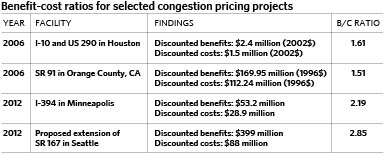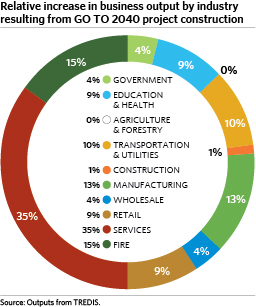In October 2012, CMAP launched a new website, www.cmap.illinois.gov/congestion-pricing, based on computer-model analysis that demonstrates the need for congestion pricing as a tool to manage traffic for faster, reliable travel times. Implementing congestion pricing on new highway capacity in the region will give drivers a new travel option and let them avoid traffic jams by taking express toll lanes. CMAP's modeling shows that, if implemented on five new GO TO 2040 construction projects, express toll lanes would allow drivers during the morning rush to reach their destinations 31 to 66 percent faster, at a modest additional cost. The five projects in that study included two new Tollway facilities -- the IL 53 north extension and IL 120 bypass and the Elgin-O'Hare West Bypass -- along with new lanes on the Tollway's I-90 Addams and Illinois Department of Transportation's I-290 Eisenhower and I-55 Stevenson.
An important remaining question is how congestion pricing would affect the regional economy. CMAP used commercially available software to model the economic impacts of these five congestion-pricing projects. As discussed in more detail below, these projects are expected to improve market access, increase gross regional product, and generate new jobs and income for the region. Furthermore, studies from other regions have generally found positive economic impacts from the operation of express toll lanes.
Overview of Economic Impact Analysis
The time drivers save by taking the express lanes obviously has value to them, as does the improved reliability of travel time, and both can be measured in monetary terms. The term "economic impact," as used here, refers to how these benefits translate into an increase in an area's employment, business output, or wages. For example, a person who drives to several appointments per day as part of work might be able to squeeze in another appointment by taking the express lanes, thus improving productivity for his or her employer. A company's drivers might be able to expand the area they can reach within a certain drive time, increasing market access. Beyond these immediate impacts, a supplier who saves on shipping costs may pass some of the savings to businesses downstream in the supply chain, giving rise to multiplier effects. In sum, these improvements to the regional transportation system might attract new businesses to relocate to the Chicago area because of its improved cost-competitiveness.
Building transportation projects also has shorter-term impacts, most significantly the creation of jobs in the construction industry. In the present study, CMAP focused only on the economic impacts of improved efficiency in the transportation system. Nevertheless, the short-term job and income impacts of construction would also be significant considering the scale of the projects.
Results for the Chicago Region
The long-term economic impacts of building these five projects recommended in GO TO 2040 and implementing congestion pricing on them include the following:
- Market access in the region would be improved by expanding the labor and consumer markets that can be reached within a 40-minute drive, improving access to airports, providing better access to intermodal facilities, and so forth. Most of the market access benefits are due to improvements in accessibility to labor and consumer markets.
- Across all seven counties, the gross regional product is estimated to increase by some $2 billion starting in 2016 due to direct improvements in access to labor and consumer markets. For reference, the economic impact model estimates a total gross regional product of $437 billion for the seven-county region in 2010.
- This scenario would result in a total of $94 billion in increased business output -- defined as final sales by industry -- in constant dollars between 2016 and 2040. Further, these projects would increase the total regional economic value added -- or the value of all an industry's outputs less its inputs –by $3.2 billion in 2040, for a total of $59 billion between 2016 and 2040.
- The figure below shows the relative impacts of this increase by industry. The analysis suggests that manufacturing, wholesaling, and transportation-related sectors would see about a quarter of this increased output, while the finance, insurance, and real estate industry (FIRE) sector and certain services would account for about half of the increased output.
Click for larger image.
- Nearly 40,000 new jobs with a total increase in wage income of some $2.3 billion are anticipated to result from investing in this scenario within a decade after the expressways open. The new jobs and income trace back to the improvements in market access provided by these facilities. The new jobs and income would phase in over time.
Congestion Pricing and the Trucking Industry
While many industries ultimately face higher costs because of congestion, the trucking industry feels congestion most immediately. Delay from congestion directly results in higher vehicle operating costs and wastes drivers' time. Trucks probably could not use the new express toll lanes envisioned for I-290, I-55, and I-90 for safety reasons, but they would benefit from reduced congestion in the general purpose lanes. CMAP calculated that congestion would be reduced on the general-purpose lanes by 24 to 33 percent. Trucks could take advantage of the fully-priced Elgin-O'Hare Expressway and the IL 53 north extension/IL 120 bypass, where they would benefit from reliable travel times. Because the trucking industry generally has high values of time, many truckers would likely find it worthwhile to pay the congestion charge.
Benefit-Cost Studies of Express Lanes Projects in Other Regions
Another way to consider the value of express toll lane projects is by comparing their benefits relative to their costs. CMAP's study did not focus on benefit-cost analysis, but a number of such studies have been conducted for projects in other regions. Generally the benefit-cost ratios for express toll lane projects are favorable (greater than 1), as shown in the case studies below.

Click for larger image.
Sources: (1)Burris, Mark and Edward Sullivan, 2006. Benefit-Cost Analysis of Variable Pricing Projects: QuickRide HOT Lanes. Journal of Transportation Engineering 132 (3): 183-190.
(2)Sullivan, Edward and Mark Burris, 2006. Benefit-Cost Analysis of Variable Pricing Projects: SR-91 Express Lanes. Journal of Transportation Engineering 132 (3): 191-198.
(3)Cao, Xinyu et al., 2012. Benefit and Cost Analysis of the I-394 MnPASS Program. Center for Transportation Studies Report CTS 12-03. Minneapolis, MN: Intelligent Transportation Systems Institute, University of Minnesota. 40 pages.
(4)Washington State Department of Transportation, 2012. Application for the FY 2012 TIGER Discretionary Grants Program: State Route 167, 8th St. East Vicinity to South 277th St. Vicinity, Northbound and Southbound HOT Lane Extension. TIGER ID: WSDOT 1297. Olympia, WA: WSDOT. 27 pages.
Conclusions
The transportation system in northeastern Illinois is an engine of jobs and prosperity. Investing in new highway capacity and implementing congestion pricing will pay dividends back to Chicago residents and businesses. The five projects analyzed here are expected to reduce traveler costs, improve market access, increase business output, and create new jobs. Many different industries would benefit, including those in freight and logistics, and the Chicago area itself could become more cost-competitive relative to other regions.
